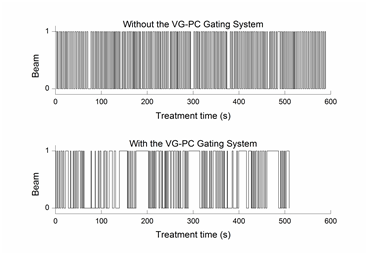글로벌 연구동향
의학물리학
![[Med Phys.] Development of patient-controlled respiratory gating system based on visual guidance for magnetic-resonance image-guided radiation therapy.](/enewspaper/upimages/admin_20171020113153_R.jpg) 2017년 10월호
2017년 10월호
[Med Phys.] Development of patient-controlled respiratory gating system based on visual guidance for magnetic-resonance image-guided radiation therapy.서울의대/ 김정인, 박종민*
- 출처
- Med Phys.
- 등재일
- 2017 Sep
- 저널이슈번호
- 44(9):4838-4846. doi: 10.1002/mp.12447. Epub 2017 Aug 8.
- 내용

그림 1. 본 개발시스템을 적용한 모습
그림2 . 실제 환자 치료 시, 본 개발시스템을 적용하지 않은 경우(상)와 적용한 경우(하)의 대표적인 예시(Y축의 1은 beam-on, 0은 beam-off)
Abstract
PURPOSE:
The aim of this study is to develop a visual guidance patient-controlled (VG-PC) respiratory gating system for respiratory-gated magnetic-resonance image-guided radiation therapy (MR-IGRT) and to evaluate the performance of the developed system.
METHODS:
The near-real-time cine planar MR image of a patient acquired during treatment was transmitted to a beam projector in the treatment room through an optical fiber cable. The beam projector projected the cine MR images inside the bore of the ViewRay system in order to be visible to a patient during treatment. With this visual information, patients voluntarily controlled their respiration to put the target volume into the gating boundary (gating window). The effect of the presence of the beam projector in the treatment room on the image quality of the MRI was investigated by evaluating the signal-to-noise ratio (SNR), uniformity, low-contrast detectability, high-contrast spatial resolution, and spatial integrity with the VG-PC gating system. To evaluate the performance of the developed system, we applied the VG-PC gating system to a total of seven patients; six patients received stereotactic ablative radiotherapy (SABR) and one patient received conventional fractionated radiation therapy.
RESULTS:
The projected cine MR images were visible even when the room light was on. No image data loss or additional time delay during delivery of image data were observed. Every indicator representing MRI quality, including SNR, uniformity, low-contrast detectability, high-contrast spatial resolution, and spatial integrity exhibited values higher than the tolerance levels of the manufacturer with the VG-PC gating system; therefore, the presence of the VG-PC gating system in the treatment room did not degrade the MR image quality. The average beam-off times due to respiratory gating with and without the VG-PC gating system were 830.3 ± 278.2 s and 1264.2 ± 302.1 s respectively (P = 0.005). Consequently, the total treatment times excluding the time for patient setup with and without the VG-PC gating system were 1453.3 ± 297.3 s and 1887.2 ± 469.6 s, respectively, on average (P = 0.005). The average number of beam-off events during whole treatment session was reduced from 457 ± 154 times to 195 ± 90 times by using the VG-PC gating system (P < 0.001).
CONCLUSIONS:
The developed system could improve treatment efficiency when performing respiratory-gated MR-IGRT. The VG-PC gating system could be applied to any kind of bore-type radiotherapy machine.
Author information
Kim JI1,2,3, Lee H4, Wu HG1,2,3,5, Chie EK1,2,3,5, Kang HC1,2,3, Park JM1,2,3,6.
1Department of Radiation Oncology, Seoul National University Hospital, Seoul, 03080, Korea.2Institute of Radiation Medicine, Seoul National University Medical Research Center, Seoul, 03080, Korea.3Biomedical Research Institute, Seoul National University College of Medicine, Seoul, 03080, Korea.4HanBeam Technology, Inc., Seongnam, 463-825, Korea.5Department of Radiation Oncology, Seoul National University College of Medicine, Seoul, 03080, Korea.6Robotics Research Laboratory for Extreme Environments, Advanced Institutes of Convergence Technology, Suwon, 433-270, Korea.
- 키워드
- magnetic-resonance image-guided radiation therapy; patient comfort; respiratory-gated radiotherapy; treatment efficiency; visual guidance
- 연구소개
- 상용화된 자기공명영상유도 방사선치료기(ViewRay system, ViewRay inc., Cleveland, OH)는 치료 빔 조사 중, 환자 호흡의 해부학적 영상을 실시간으로 획득할 수 있고, 이를 바탕으로 호흡동조 방사선치료를 수행할 수 있다. 본 연구는 호흡동조 자기공명영상유도 방사선치료 시, 환자가 본인의 해부학적 영상을 스스로 실시간 모니터링하면서 자신의 호흡을 조절, 효율적인 active breathing control을 가능하게 하는 시스템을 개발하는 것이다. 치료실 내부에 빔 프로젝터를 설치하고, Treatment console에서 생성되는 실시간 MRI 영상을 치료기 bore 내부 상단에 투사하여 환자가 자신의 호흡영상을 모니터링 할 수 있도록 하였다. 본 시스템을 적용한 결과, 5명의 SABR 환자를 포함한 6명의 환자에 대하여 평균 치료 시간이 1887.2 초에서 1453.3 초로 줄어들었고, 평균 beam-off 시간도 457번에서 195번으로 줄어들었다.
- 덧글달기








편집위원
최근 의학물리분야에서 관심을 일으키는 두 가지 이슈는 Deep Learning 과 MRI-Linac입니다. 이 논문은 MRI-Linac은 아니고 MRI-Cobalt60 치료기 이지만 충분히 흥미로운 내용을 포함하고 있다고 생각합니다
덧글달기닫기2017-10-11 15:30:46
등록